The Markings of Music: “Canoe Chase on the Horican” & “Narra-mattah” by Matthew Klane and James Belflower
Canoe Chase on the Horican


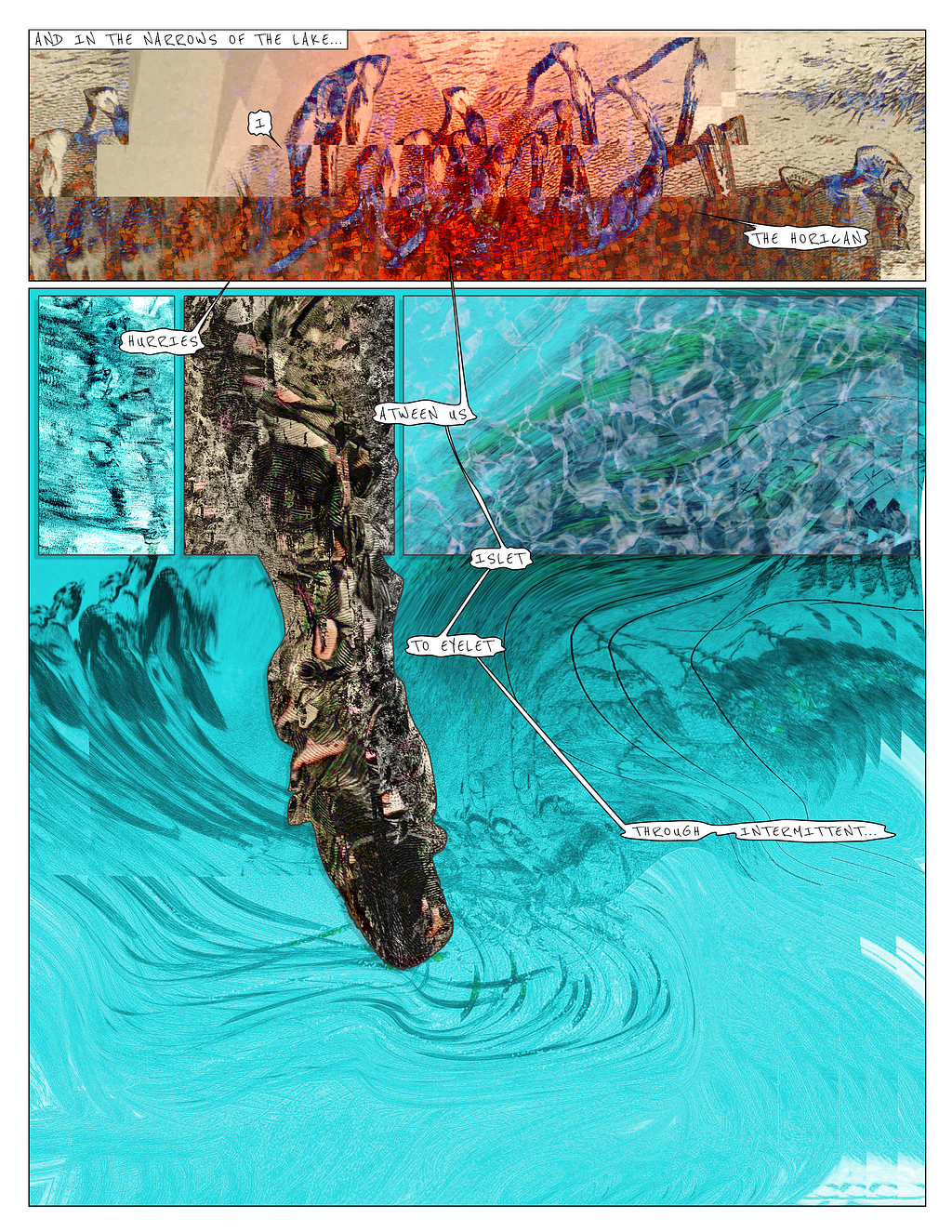
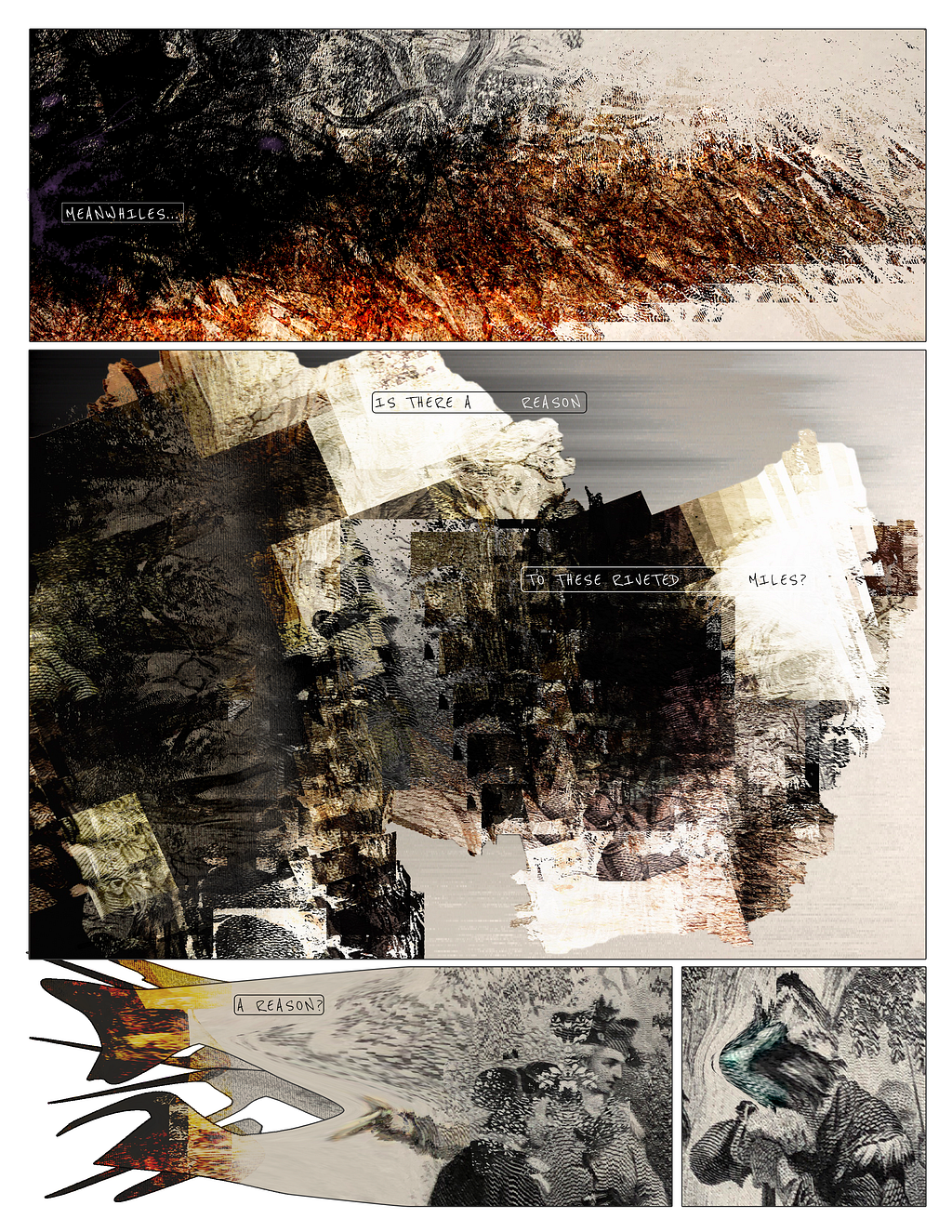
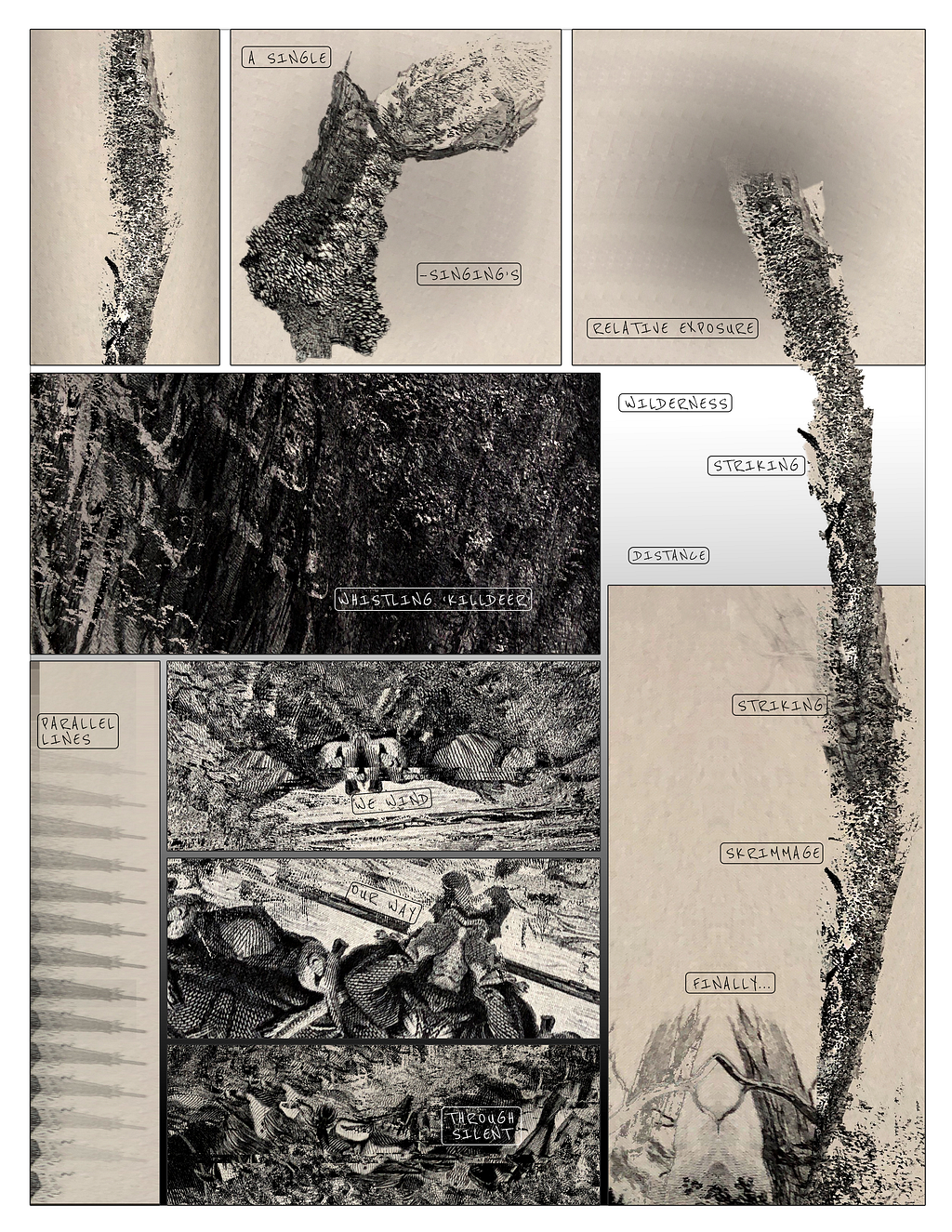

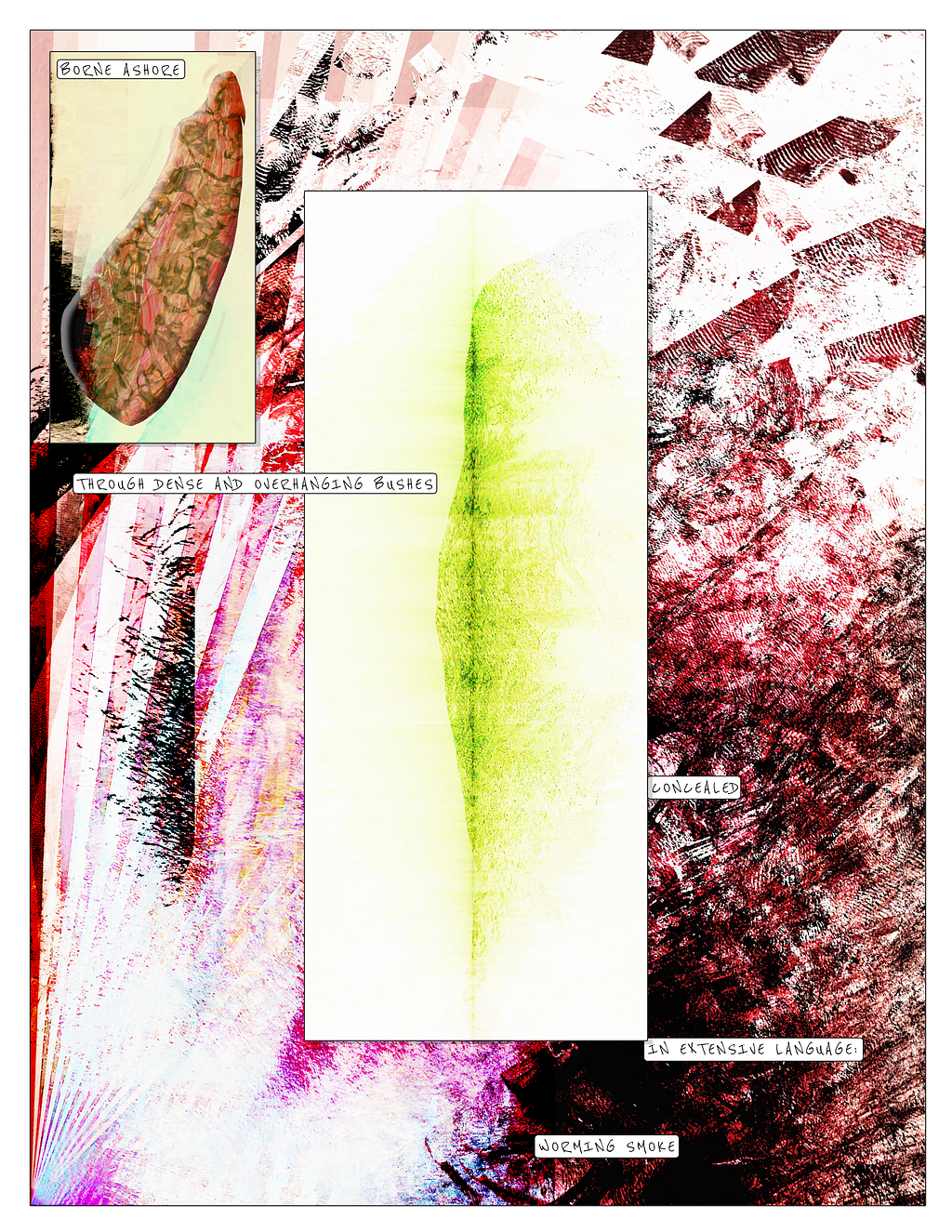
Narra-mattah
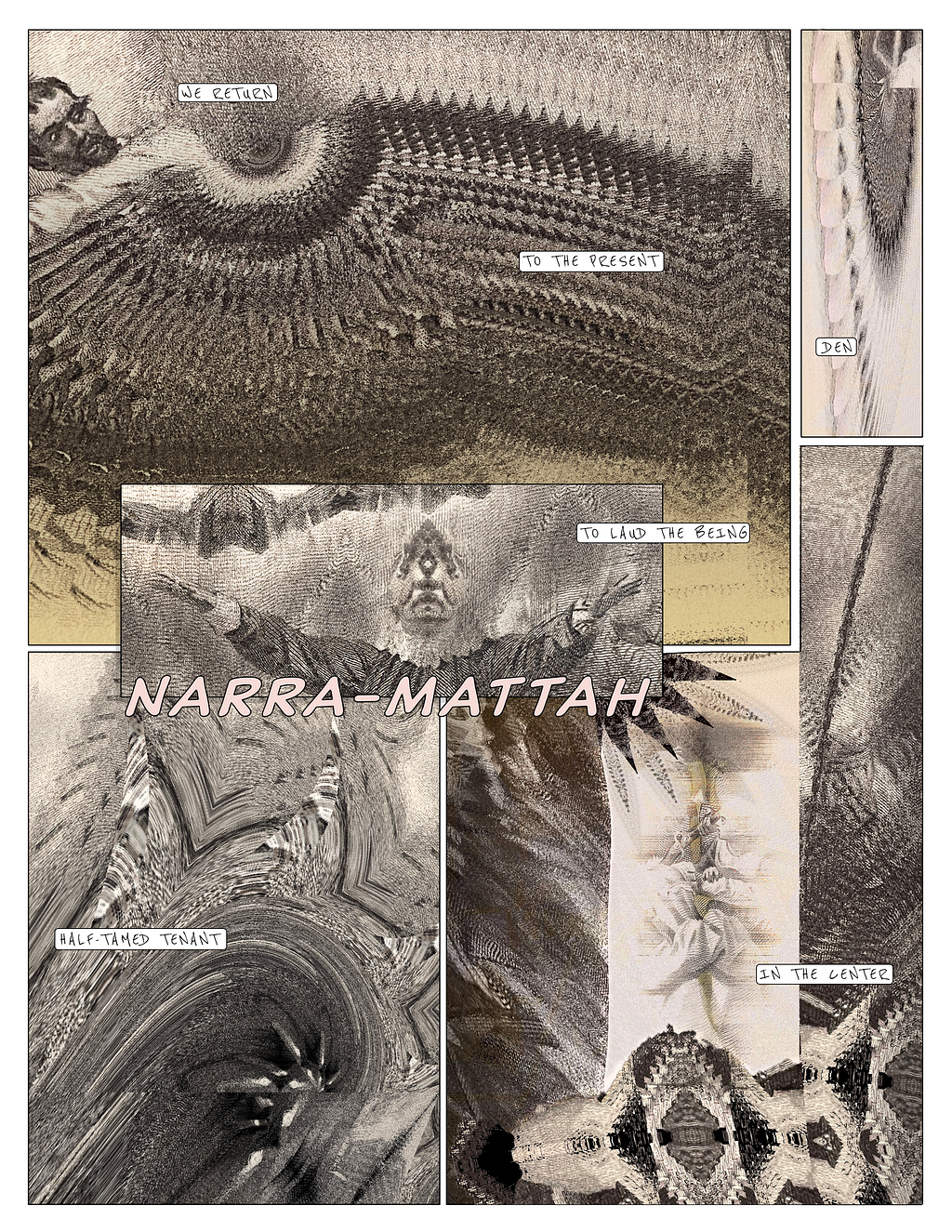
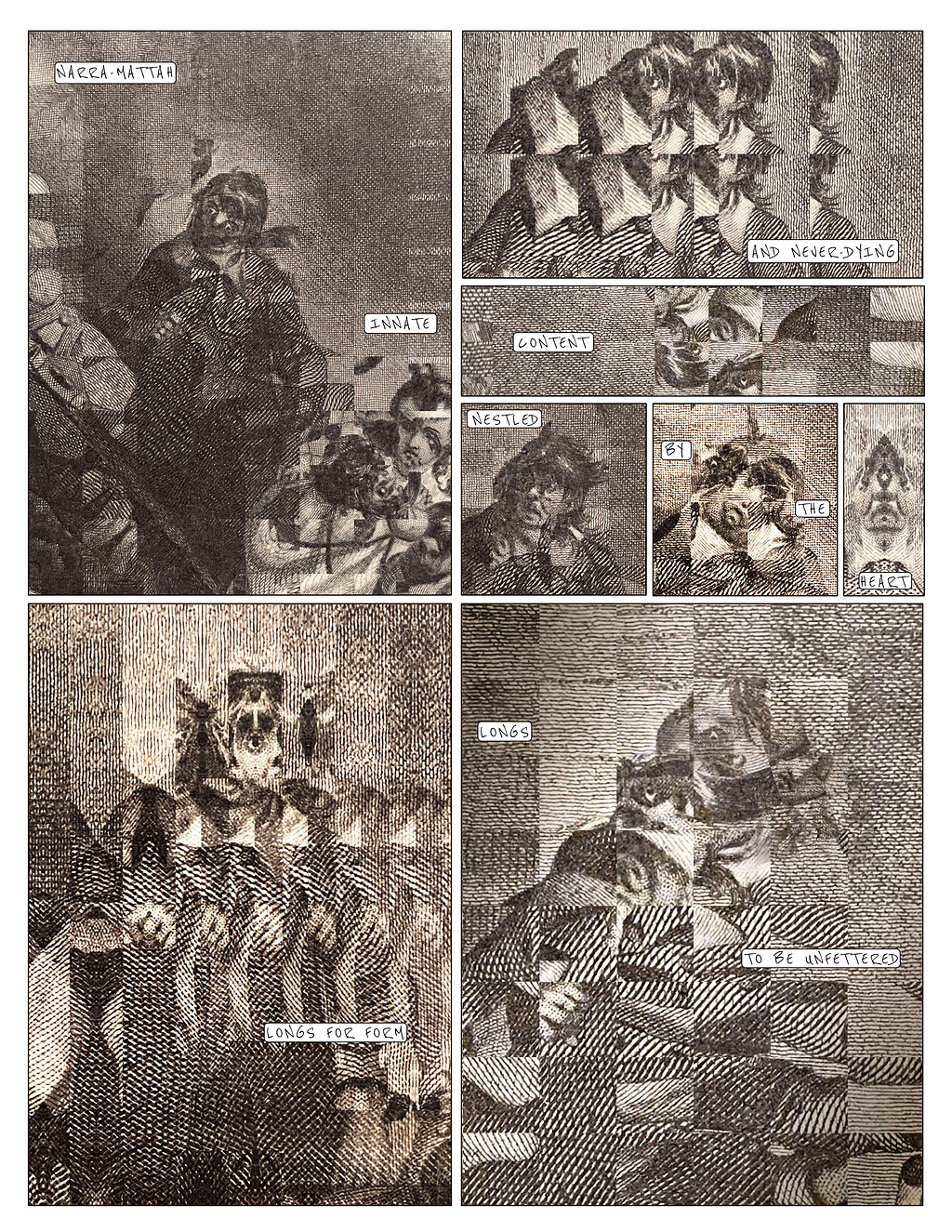
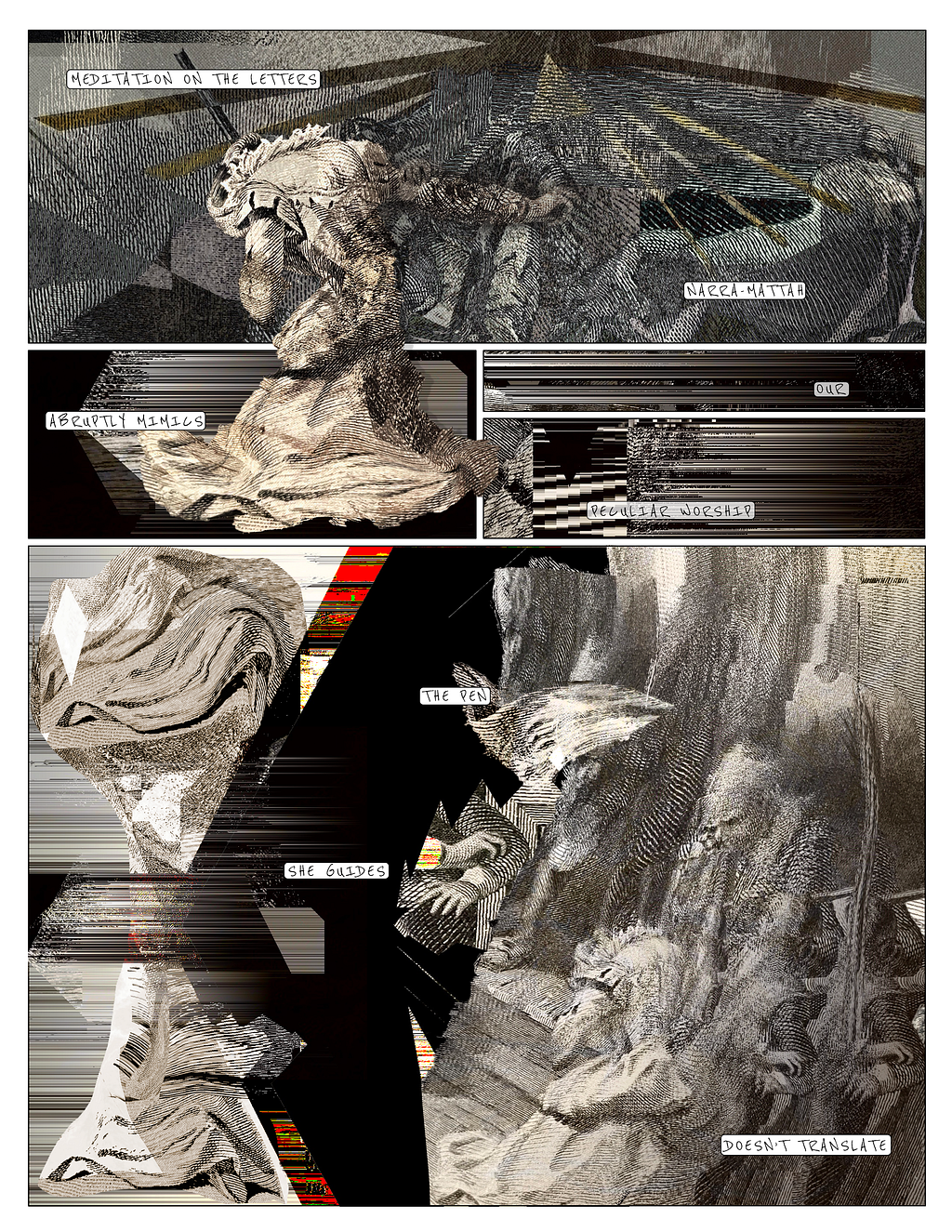
Artist(s) Statement:
WINDJAMMING
Matthew Klane: Where are we, James?
James Belflower: We’re in my backyard in Rensselaer, upstate NY. Sitting next to a playset. Encircled largely by a forest of tall trees. Which is a lot of what you’re hearing.
MK: What are these?
JB: LOM basicUcho omnidirectional microphones. So we can capture the environment while we talk.
MK: But what are those things on the ends of the microphones?
JB: Windjammers. So we can also hear ourselves.
MK: A windjammer… jams the wind?
JB: That’s exactly right.
MK: Jamming the wind, though, could mean blocking the wind. But it could also mean playing the wind!
JB: [mimes deep thinking]
A STRANGE DIVE
MK: I had found this book in the English department office at Russell Sage College where I taught. For years, I’ve been saying that there was nothing on the cover of this book. Seeing it again now, however, for the first time in a while, there is a very faint “C” — what’s the word? — embossed onto the green hard cover. I’ve also said that the spine of the book only read “Chapters.” In fact, it reads: “Chapters” and then: “James Fenimore Cooper.” That’s not the way I remember it. I remember a blank-covered book with only “Chapters” on the spine, and me being like, “That is so provocative!”
JB: It’s provocative anyway!
MK: I didn’t know a lot about Cooper. I’d seen Daniel Day Lewis in Last of the Mohicans. I’d read the Natty Bumpo stories in 10th grade Honors English. A class that made me not take Honors English in 11th grade. Because I did so poorly. And was so disinterested. In this case, though, I was very excited by this book. The pages are gilded with gold and it has a little green ribbon, you know, so you can mark your place.
JB: I brought it out here. Looks like the gold is only on the top of the pages. And the spine is printed upside-down.
MK: Yes, it has the feeling of a very old book. And yet, when you look inside, you’ll find that it was printed in 1986 by something called the Westvaco Corporation. And there’s this really strange foreword. The voice is so dramatic. A scene is set. Walking through a town, a classic American small town, which turns out to be Cooperstown, NY.
JB: There’s such grandeur. The word pilgrimage is used. When I read the foreword now, there’s a part of me that strangely feels like it’s describing how we found the book. I don’t know what it is. Like some sort of serendipity, some sort of voice in the wilderness.
MK: This voice wanders into a book barn, and there, on a high shelf, a set of books calls to him. The writings of James Fenimore Cooper. So this voice decides to do an anthology of Cooper stories. They’re not short stories. They’re excerpted chapters from novels. You don’t have context for the larger stories, but altogether, you’re going to get… what? a vibe? a universe? a sense of Cooper’s interests and preoccupations? Early American civilization, adventure, disaster, war, fringe encounters with Native peoples. I had this anthology on my shelf for a few years before it started calling to me. So I decided, like I normally do when I start a project, to glean and rip text from each chapter, to form a series of soundscapes. My own “chapters.”
JB: You took tiny chunks out of what are clearly longer narratives.
MK: A series of longer narratives — which were, themselves, already excerpted from novels! These were like the first American mass market novels. I learned that when I had to teach Cooper. You know how, like, when you’re a weirdo poet, but then they ask you to teach American Lit 1 or something, and you have to do a lot of reading? That summer, I had to read the whole Norton American Lit 1 survey, all of the intros, do a little bit of research, figure out what authors I was going to teach. At that point, I learned that Cooper is considered to be the first American novelist. Like the first to actually sell books. To be popular. That’s the word I’m looking for.
JB: Brings back memories — so much reading! Of course, your pieces are much, much, more concise. We’re talking like 20–30 words from each chapter. So there was the difficulty of seeing the larger picture, what’s actually occurring.
MK: And I didn’t really tell you much, either. I just sort of gave you the Cooper volume along with my little soundscapes: “Here, James. What can you do with this?” We had collaborated before, on a similar project (Canyons), also invested in 19th century America-making, and I thought maybe this, whatever it was, could be our next book.
JB: I was, as usual, very intrigued. I glanced through the book at first, not really reading anything deeply, but I remember thinking these are wonderful images. Framing each chapter, the anthology includes some original illustrations — steel engravings — images that accompanied the novels. So I have this app on my iPhone called Decim8. It’s advertised as the “antithesis of Instagram,” which just totally destroys an image. Pixel by pixel. And I put the 19th century images through this app, 30–40 times each, and the distortions were really energetic. Many of them didn’t leave anything recognizable, but they had a level of activity that really reflected the drama of the originals. In a way it really became an exercise in visual “deformance,” to evoke Lisa Samuels. And, at some point, I thought, this visual energy might translate into comic panels.
MK: You sent me early versions of the first two chapters of HIST laid out. And I was like, “Okay! It’s a comic book! Obviously!” I mean, I had no idea we were doing a comic book, but then when I saw it, I was like, “Yes. Of course. This is perfect.”
JB: I appreciate your willingness to collaborate! I had always wanted to make a comic, and in our previous collaboration, Canyons, we collaged some text and image, but they were mostly separated. Here, I thought, “Let’s see what happens if I start laying the text over the images?” Strangely, I was putting visual narrative back into your text constellations. For the images, one of my constraints was that, in each one of our chapters, I could only use the source image that corresponded to the original Cooper chapter. So there was a relationship built in from the beginning.
MK: I love that. It’s similar to when you excavate text from a single lexicon, you can play around with it, and reconstruct it, and rearrange it, and reconfigure it, without thinking about tenor, necessarily, or semantics, and you can trust that there’s a kind of foundation underneath. It frees you up to make meaning in less traditional ways.
JB: Great point. It’s hard to break the system, but you don’t want to merely duplicate the system either. You have to deform it, to change it.
THE ESSENCE OF THIS PLACE
JB: We had a sound component to our first collaboration, Canyons. I had a sound component to my solo book, The Posture of Contour. But I thought, in particular, this project, HIST, was ripe for an actual soundtrack. The visual and the auditory just really came together during the composition. While I put the text and the images together, in those fragmentary moments, I couldn’t help but hear voices. Or more like vocalizations, vocal sweeps. Moans or cries floating in and out of these visual landscapes.
MK: I like that you dropped the word soundtrack. Because when I saw those first pages, I also started thinking about comic book movies, you know, Marvel Universe stuff. Going from Cooper, and these early popular stories, myths of America, and then thinking about contemporary popular stories, big cinema, blockbusters, especially now, in this very particular clusterfuck of a time period that we’re living through. Like maybe you and I were now making some blown up post-apocalyptic 19th century blockbuster.
JB: Very much so. I was inspired, early on, by the Candyman redux. Which, if you haven’t seen it, is an awesome movie! The composer, Robert Aiki Aubrey Lowe, took these LOM microphones — it was the first time I’d heard about them! — and went to one of the film’s settings, the controversial Cabrini-Green public housing complex in Chicago. It’s now mostly luxury condos and retail but some of the original structures remain. So he listened to the ghosts of abandoned buildings. He wandered around, listened to the wind coming through, opened doors to fuse boxes, found small squeaks in the corners of rooms, collected noises, trying to create an aural terrain from the essence of this place in a way that was so material and physical.
MK: When did you start collecting noises for our book?
JB: I’m kinda always collecting. It’s an ongoing process. An active listening that’s also part of my writing practice. And I think yours, too. I’ve been collecting field recordings for the last 5–6 years. I started during my PhD as a way to create with writing. Many of the sounds for HIST, though, were made new from recording projects around the house. Like digging ditches. I’d hear a particular clack of my pickaxe and run inside to get my equipment. I took my recorders and set them up out here. And then I would listen to what that sounded like as a way to keep a creative practice going that wasn’t writing.
MK: Where were you digging ditches? Right here in this backyard?
JB: Yeah, I had to redo the drain-pipes on the house. Each one needed about 6–12 feet of runoff that needed to be buried about a foot deep. So I dug ditches out with a pickaxe and a trench shovel, all the while recording.
I CAN TRANCE
JB: In “Canoe Chase,” you’ll hear this broken rubber band “instrument.” It’s literally just rubber bands stretched over a music box and a broken glass beaker, and then stretched across a piece of slate flooring from our house with a contact mic on it. I can’t remember where I found the music box, but the whole outside of it is crunched. Parts of it still resonate in different areas, though, so when you flick the rubber bands, it slaps the tines or tongs and the glass picks that up.
MK: That sounds less like a found sound than a composed sound.
JB: True. Though it started as found objects, I guess, and then those might become little ad-hoc noisy inventions. Kinda like a poem!
MK: There’s also this moaning throughout “Canoe Chase.”
JB: That’s me singing a paraphrased line from the poem, “Where oh Where, a white voice,” but run through an autotune, and a bunch of other effects, to create a “vocal violin.” In that piece, too, on a loop, there’s a conversation between my partner Jess and I. You can hear the click click click of the wind coming into our kitchen through the vertical blinds. As we’re talking about the birds that are singing outside.
MK: Windjamming!
JB: Yes! There are a lot of birds in the soundtrack. If you’re recording outside, they’re hard to avoid. Like this one singing right now [birdcall in a nearby tree]. Listen. It’s kind of spectacular. That’s a black catbird. You can hear the wonderful rhythm. That quick repetition. And the degree of scale that this bird leaps through. We hear this one all the time. Sometimes, it’s like right outside my bedroom window, and I’ll be like, “Dude, c’mon. Enough already. Move along.” But there’s nothing you can equate with that sound. I think the composer Olivier Messiaen comes the closest in his Catalogue d’oiseaux, or “Catalog of Birds.” Where he tries to put bird song into piano. That’s an amazing piece!
MK: Are there other sounds in “Canoe Chase”?
JB: Toward the end, there’s the sound of a ball bouncing through my house. And then me following after it. You can hear the reverberant creak of wooden floors. That sound overlays part of the modular drone, which ends “Canoe Chase.”
MK: Wow! It’s fun for me to discover this. I love the image of a ball bouncing through a house. And thinking about you and Jess just looking out the window, observing, listening to birds, capturing a moment, interacting, that so easily translates. Because “Canoe Chase” kind of quietly winds its way through whatever its winding through. There’s a slowness, a slow traveling, that you conjure in that piece.
JB: Yeah, you’ve called “Canoe Chase” your favorite piece. In performance, there’s a way that you seem to sit in that piece differently than some of the others.
MK: That’s it. Because I can sit in it. Like sitting down in a canoe! I kind of sway back and forth in front of the microphone. Peeking out from the left. And peeking out from the right. Just keeping on guard as we make our way down the river. Meandering through time. And you just have to roll through that poem. It’s very meditative. I can trance. It’s not that I don’t enjoy all of the pieces, but I’m often negotiating with other sounds in ways that don’t feel good. I’ll need to either rise up to a moment, or back off, or compete. That’s all in the adventure of HIST. At times, the voice is grieving in community, or battling, or getting revenge, or being overwhelmed by monsters hovering over the shoulder.
TO LONG FOR FORM
JB: If you look at that first page of the “Narra-mattah,” chapter, you’ll see who I kind of envision as the character, “Narra-mattah,” in the center panel with the distorted face and arms outstretched. They are either worshipping or demanding worship. It’s hard to say.
MK: What is that dark voice that opens the track?
JB: That’s me! Slowed down quite a bit. And the text is an excerpt from our source text, which is an excerpt from Cooper’s The Wept of Wish-ton-Wish.
MK: Oh, so, at some point, you went back into Chapters and picked out some other text to fit into the project?
JB: Yeah, for this track, in particular, to frame the piece. That slow deep voice returns at the end to guide us out.
MK: I think of the early part of “Narra-mattah” as an invocation. That deep slowed-down voice somehow sounds like a welcoming. A dark welcoming. It calls everyone to attention. Into a kind of ritual space.
JB: I love that idea of an invocation. Maybe it’s the preparation for acceptance into the “family” the voice mentions? The drone that follows this voice was actually recorded right outside of my house. I found this giant moth just floating over some flowers. And managed to get very close to record its wings fluttering. So that was the initial sound. There are many more sounds layered over, but there’s a way in which the soft flutter of that moth still lingers. But it’s really thick and fills a lot of space, like the guitar solo it leads to.
MK: That guitar solo isn’t really a guitar though, right?
JB: No. It’s just a soft synth. Made specifically for that sound. That reminds me, one of the members of the band Gang of Four happened to be at one of our performances. And he said to me: “That was like a Pantera riff in the middle of all that!” And I was like, “Wow! Thanks! Awesome!”
MK: Yeah, my friend Randall teaches at a college north of Boston and invited us to perform there. And this guy from Gang of Four just happened to be on faculty.
JB: My take on “Narra-mattah” is that it’s largely about form and formlessness. I think, during that first part, in the music itself, we get a sense of some spirit longing to take form. And then we get the thick drone as that spirit amasses, and then that guitar solo cuts in, as if finally cohering, but painfully. The spirit’s attempt to take on form is not a quiet thing. It’s pretty raucous!
MK: In “Narra-mattah,” I wait a long time to say anything, but I do like the long buildup, the anticipation. Before I’m allowed to speak in that space, certain things have to happen. Arrangements have to be made. The proper deities have to be called upon [laughing]. And then I’m allowed to enter the poem. After the guitar solo winds down, we descend into — what feels like to me — a quiet, dripping, cave. How did you create that atmosphere?
JB: Towards the end of that chapter, there’s a character who’s bent over with a hand reaching out to the side. In a subservient, but also maybe fearful, bow or kowtow. To me, it looks likes they’re in grief or anger, but also reaching for something. What sounds would evoke this image? So, I took this piece of wood, wrapped with leather, and twisted it through my bare hands. Skin on patent leather. Claire Rousay does something similar in one of her Quarantine concerts. You can hear the extended, tortured, low squeal. And then I laid over the hollow sounds of water. “Narra-mattah” is one of the few instances where we have an effect on your voice. Just a little delay so you can also float in that hollowness!
MK: Looking at that character, the one you’ve described, you never see a face. They could be the same character. And you were saying earlier how there’s some confusion here between the worshipper and the worshipped. I actually think about “Canoe Chase” like that. The people being chased and the people doing the chasing. They’re the same.
MAGIC SEEDS
JB: The image on the cover of HIST, that large spiky ball that looks like a meteor, it’s actually a 3D rendering of a chestnut shell. It’s technically called a burr. I scanned it using Polycam.
MK: That’s a chestnut?
JB: A chestnut shell. I’ve had it for a while. I’m so fascinated by its shape. It’s super spiky on the outside. When you rub your fingers across the spikes, they’re incredibly sharp. Like needles. So it’s kind of a masochistic exercise! But they make a very faint clicking. And with a quality microphone, you can really capture it.
MK: That’s the thing that, in performance, I’ve seen you kind of twirling, twisting, and rolling it around between your fingers. Under a contact mic?
JB: It’s a high-end condenser. It picks up the acoustic properties more than just the contact properties.
MK: There are some pictures of you, and I’ve snuck some peeks while we’re playing. And with the lights out, and just a small light on you, and that spiky orb in your hands, it looks quite magical.
JB: It’s a really cool experience, because, for me, it creates a new relationship to the object. It reminds me of what Lawrence English calls “relational listening.”
MK: Who’s Lawrence English?
JB: A wonderful composer and theorist. He wrote an article called “Relational Listening” where he makes an argument about field recording as an art form in-and-of itself. He’s been a big influence. Along with the musician and poet Felicia Atkinson and Kate Carr. These two are like mentors, taking the whole idea of sonic materiality to another level. Improvising extended pieces with any and every object you could think of, you know, anything that might resonate in some way.
MK: In performance, you have this little tray of objects that you keep by your side. Things that you “play” in performance.
JB: There’s a singing bowl in there, but it’s mostly found objects. Some nails. Various screwdriver bits. A couple of glass pieces, skateboard grip tape, an awl, some different dried flowers and stalks.
MK: I remember, before one of our shows, I was carrying in your “magic box,” and something had broken. Some piece of organic material had been ruined and was unplayable.
JB: It was dried seed pods. There are quite a few lilies in front of our house. And when they dry out in winter, they leave these really thin stalks topped with tiny, brittle, oval enclosures. They’ll be some seeds in there, so if you snap off the pods, and collect like 10 of them into a head, you can create a very primitive rattle. Eventually, the seeds will fall out, but you can still use the pods. The tops of the leaves curl out, almost like they’re mid-flower, and will crinkle together in really beautiful ways.
MK: Yeah, but that night, it was like, “Oh no! The seed pods are ruined! Show’s over!”
JB: We had a running joke: “What’s my instrument? Oh, I play the seed pods. Sometimes the chestnut.” But don’t worry. I was able to find some more seed pods, so we’re okay.
MUSIC WRITING
MK: We always walk into a venue like, “Okay, let’s see what challenges this room is going to present?” We need an hour, hour and a half to set up, at least, which you don’t always get with poetry readings. We have to carry in a lot of equipment. I’ve noticed you several times before a performance, setting up, taking a break, wandering around the room, staring into the corners of the ceiling. Like my cat does. You’re just trying to figure out what sounds are bouncing off what.
JB: There is a tension that I both enjoy and find a little terrifying. Every time, we have to negotiate with the environment: “How is this going to work? How can we duplicate what we’re hearing in our heads in this particular space?” Our very first show was at Unnameable Books in Amherst, MA, and the space was the size of a slightly large closet. The audience only four feet in front of us.
MK: Shoutout to the very generous Adam Tobin and Catherine Bresner! Who invited us to perform at Unnameable Books, essentially, in the back aisle of the store.
JB: Great community! Great conversations afterwards! And our set went fine. One of the challenges, though, is that we are poets playing poetry venues, in front of an audience expecting a poetry reading. But we’re coming in with a full sound setup. So there’s some dissonance there: are we doing a poetry reading or playing a concert? What is this?
MK: You just brought up like literally not living comfortably in poetry spaces. But, more generally, too, what is HIST? Is it poetry? Or a graphic novel? Or music? Or poetry plus? Or poetry plus music? That set of questions makes me think about the name of this blog: “Music Writing.”
JB: It does. There is a lot of slippage in that term: “Music Writing.” Is it language’s push toward the ear: upper limit music? The musicality of the language? Or is it writing that incorporates musical references?
MK: In my understanding, it’s a provocation. To think about, and explore, poets’ and poetry’s relationship to music.
JB: I like that. For me, let’s say, to start, it’s attention to the acoustic properties of the language itself. And then its whether you’re amplifying, muting, modifying, or subverting those properties. Take, for example, your poems in HIST. There’s a way in which your words constellate, call to each other, reverberate, create something linguistically resonant, even when they are spread so distantly across the images.
MK: I think it’s because I often try my best to work at the level of the syllable. Sometimes, the letter. Use alliteration, a front rhyme here, a visual rhyme there, across a poem, throughout a poem. Into the belly of each word. And then outward into the ether. The comic book form really helps here, also. To make ears and eyeballs move, you know, multi-directionality. To make references between words that you can’t make otherwise. To create a kind of atmosphere.
JB: Yes, atmosphere! I’m reminded of that comment Rosmarie Waldrop makes in “Shall We Escape Analogy” about the desire of language for itself. I really love this idea. Because, for me, so much of that desire is acoustic. That next word wants to resonate with the one that came before and it wants to vibrate with what comes after. And echo one that came two lines ago, two lines later. There is a network of desire that a poem enacts, and it resonates, like a bell, ringing out.
***
Note: “Canoe Chase on the Horican” & “Narra-mattah” were originally published in HIST (Calamari Archive, 2023). An earlier version of “Canoe Chase on the Horican” appeared in Diagram. An accompanying soundtrack to HIST is forthcoming from Calamari Archive.
James Belflower is a multidisciplinary artist and poet, and Teaching Assistant Professor at Siena College. His work investigates how language mingles us with matter. He is the coauthor of the graphic novel HIST (Calamari Press 2022), and the multimedia text Canyons (Flimb Press 2016) with Matthew Klane; The Posture of Contour (Spring Gun Press 2013); Commuter (Instance Press, 2009); and Bird Leaves the Cornice, winner of the 2011 Spring Gun Press Chapbook Prize. His work appears, or is forthcoming, in Postmodern Culture, Journal of Modern Literature, Diagram, and Sleeping Fish, among others.
Matthew Klane has an MA in Poetics from SUNY Buffalo and an MFA in Poetry from the Iowa Writers’ Workshop. His books of poetry include Hist (w/ James Belflower, Calamari 2022), Canyons (w/ James Belflower, Flimb Press 2016), Che (Stockport Flats 2013) and B (Stockport Flats 2008). An e-chapbook from Of the Day is online at Delete Press, an e-book My is online at Fence Digital, and a chapbook Poetical Sketches is available from The Magnificent Field. He is co-founder of Film Forum Press and currently co-curator of Salon Salvage, a poetry and performance series inside of Weathered Wood in downtown Troy, NY. See: www.matthewklane.com.
The Markings of Music: “Canoe Chase on the Horican” & “Narra-mattah” by Matthew Klane and James… was originally published in ANMLY on Medium, where people are continuing the conversation by highlighting and responding to this story.
